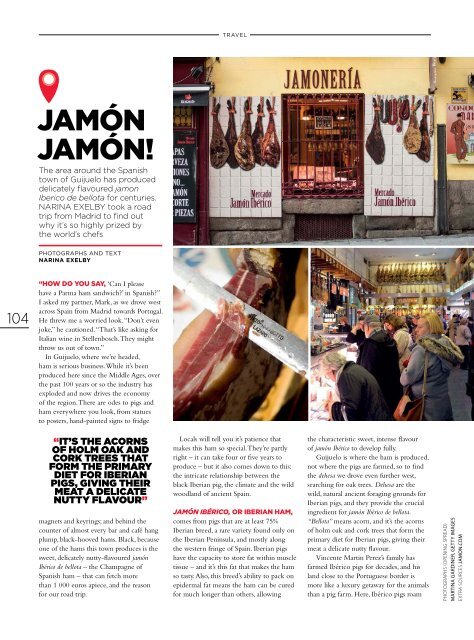Woolworths_Taste_July_2017
Create successful ePaper yourself
Turn your PDF publications into a flip-book with our unique Google optimized e-Paper software.
TRAVEL<br />
JAMÓN<br />
JAMÓN!<br />
The area around the Spanish<br />
town of Guijuelo has produced<br />
delicately flavoured jamon<br />
Iberico de bellota for centuries.<br />
NARINA EXELBY took a road<br />
trip from Madrid to find out<br />
why it’s so highly prized by<br />
the world’s chefs<br />
PHOTOGRAPHS AND TEXT<br />
NARINA EXELBY<br />
104<br />
“HOW DO YOU SAY, ‘Can I please<br />
have a Parma ham sandwich?’ in Spanish?”<br />
I asked my partner, Mark, as we drove west<br />
across Spain from Madrid towards Portugal.<br />
He threw me a worried look. “Don’t even<br />
joke,” he cautioned. “That’s like asking for<br />
Italian wine in Stellenbosch. They might<br />
throw us out of town.”<br />
In Guijuelo, where we’re headed,<br />
ham is serious business. While it’s been<br />
produced here since the Middle Ages, over<br />
the past 100 years or so the industry has<br />
exploded and now drives the economy<br />
of the region. There are odes to pigs and<br />
ham everywhere you look, from statues<br />
to posters, hand-painted signs to fridge<br />
“IT’S THE ACORNS<br />
OF HOLM OAK AND<br />
CORK TREES THAT<br />
FORM THE PRIMARY<br />
DIET FOR IBERIAN<br />
PIGS, GIVING THEIR<br />
MEAT A DELICATE<br />
NUTTY FLAVOUR”<br />
magnets and keyrings; and behind the<br />
counter of almost every bar and café hang<br />
plump, black-hooved hams. Black, because<br />
one of the hams this town produces is the<br />
sweet, delicately nutty-flavoured jamón<br />
Ibérico de bellota – the Champagne of<br />
Spanish ham – that can fetch more<br />
than 1 000 euros apiece, and the reason<br />
for our road trip.<br />
Locals will tell you it’s patience that<br />
makes this ham so special. They’re partly<br />
right – it can take four or five years to<br />
produce – but it also comes down to this:<br />
the intricate relationship between the<br />
black Iberian pig, the climate and the wild<br />
woodland of ancient Spain.<br />
JAMÓN IBÉRICO, OR IBERIAN HAM,<br />
comes from pigs that are at least 75%<br />
Iberian breed, a rare variety found only on<br />
the Iberian Peninsula, and mostly along<br />
the western fringe of Spain. Iberian pigs<br />
have the capacity to store fat within muscle<br />
tissue – and it’s this fat that makes the ham<br />
so tasty. Also, this breed’s ability to pack on<br />
epidermal fat means the ham can be cured<br />
for much longer than others, allowing<br />
the characteristic sweet, intense flavour<br />
of jamón Ibérico to develop fully.<br />
Guijuelo is where the ham is produced,<br />
not where the pigs are farmed, so to find<br />
the dehesa we drove even further west,<br />
searching for oak trees. Dehesa are the<br />
wild, natural ancient foraging grounds for<br />
Iberian pigs, and they provide the crucial<br />
ingredient for jamón Ibérico de bellota.<br />
“Bellota” means acorn, and it’s the acorns<br />
of holm oak and cork trees that form the<br />
primary diet for Iberian pigs, giving their<br />
meat a delicate nutty flavour.<br />
Vincente Martin Perez’s family has<br />
farmed Ibérico pigs for decades, and his<br />
land close to the Portuguese border is<br />
more like a luxury getaway for the animals<br />
than a pig farm. Here, Ibérico pigs roam<br />
PHOTOGRAPHS (OPENING SPREAD)<br />
MARTINA GARDINER, GETTY IMAGES<br />
EXTRA SOURCES JAMON.COM

















